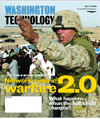A Washington Technology Special Report on New Defense Opportunities

Even as the Defense Department builds a massive information grid often referred to as "network-centric warfare," experts say a new generation of software and sensors is needed to fulfill its promise. In a special report, Washington Technology found integrators and defense leaders struggling over how to make tactical use of the emerging network.

Carl O'Berry, vice president of Boeing Strategic Architecture, said sensors can be connected in mobile ad hoc networks. Such networks can provide communications in locations where bandwidth is in short supply.

"We can tell the elephant moved from here to there. We need to know if the elephant took a drink." ? Stan Sloane of Lockheed Martin
Henrik G. de Gyor

John Garstka of DOD's Office of Force Transformation said network gateways that will move information to the battlefield need to be developed.
Henrik G. de Gyor

In the coming weeks, the Defense Department will make public a series of case studies on network-centric warfare. Written by systems integrators and retired military officers for the department's Office of Force Transformation, the case studies chronicle the performance of networked forces in Afghanistan, Iraq and other theaters.
In a conference room at OFT's Rosslyn, Va., offices, Washington Technology was shown early drafts of several case studies, including one that promises to foster a different kind of discussion about network-centric warfare and the potential opportunities for new technology initiatives.
The question it tries to answer: How does network-centric warfare apply when there is no war?
The case study describes network-centric technologies in what the authors call "operations other than war" during a NATO peacekeeping mission in Macedonia. In 2002, the Royal Netherlands Army took over Operation Amber Fox, a 1,000-troop NATO task force to protect international monitors.
By building a wide area network and an information management system, the task force successfully created a shared picture of the operating space to help them respond more effectively.
Although the differences between a peaceful Macedonia and a volatile Iraq are stark, the attempt to find lessons in what experts now carefully refer to as network-centric operations, instead of network-centric warfare, signals both an expanding focus and an acceleration of the Defense Department's technology initiatives, experts said.
Until now, the emphasis has been on building networks that help in targeting and command and control. The bulk of the department's case studies and ongoing transformation continue to be about traditional warfare.
But operations in Afghanistan and especially in Iraq, where troops are deployed in a non-traditional battle zone, have tested the limits of the U.S. military's network-centric capabilities. Sophisticated systems can identify and destroy enemy targets that are miles away, but such systems were not designed for soldiers patrolling crowded streets.
After weeks of interviews, analysts, integrators and defense leaders agreed that plugging the military into a pervasive network is one thing; filling that network with useful information is another. Some critics said the Defense Department may be overemphasizing information technology. Other experts said it's time to take the next step in network centricity.
"If network-centric warfare 1.1 was about infrastructure, network-centric warfare 2.0 will be about sensors and software," said Kevin Coleman, senior fellow at the Technolytics Institute, a McMurray, Pa., think tank.
SENSING THE ENEMY
Even before Operation Iraqi Freedom, the Defense Department was using sensor technology for a variety of purposes, including monitoring battlefield conditions and enemy movements. But as the military struggles to identify threats during the Iraqi insurgency, sensors have climbed the department's wish list.
"Suppose you had an autonomous sensor that could fly ahead of a convoy and look for explosives along the road," said James Lewis, director of technology and public policy at the Center for Strategic and International Studies in Washington. "That technology is within our grasp."
Both Boeing Co. and Science Applications International Corp., prime contractors on the Army's Future Combat Systems program, acknowledged that the Defense Department has elevated its requirement for sensors to help fend off rocket-propelled grenades and so-called improvised explosive devices.
[IMGCAP(2)]Dan Zanini, SAIC vice president and program manager for Future Combat Systems, said the entire program has risen in importance based on lessons learned in Iraq. Just one year into the contract, Zanini said the program has grown to 17 companies and more than 5,000 people.
"FCS has become a more immediate requirement," Zanini said. "They tell us they need it today."
The Army is making that point to industry loud and clear. Lynn Schnurr, the Army's deputy chief of staff for intelligence, told an industry gathering the service needs more sensors, including unattended ground sensors and unmanned aerial vehicles (UAVs).
"We need to have persistent surveillance. If we have persistent surveillance, we can better predict and prevent our soldiers from being injured and killed," Schnurr said.
Extensive use of sensors presents a pair of challenges that integrators must address: how to network the sensors and how to manage the data they produce.
Carl O'Berry, vice president of Boeing Strategic Architecture and retired Air Force lieutenant general, said the solution to the first problem rests in mobile ad hoc networks. Not only could such networks organize themselves on the fly to ensure data gets to the right command center, they could provide communications in austere environments where bandwidth is in short supply.
With the right connectivity, O'Berry said, "anything with a battery becomes property of the network. It's a network infrastructure that brings bandwidth with it."
Addressing the second sensor challenge, taking data and making it useful will require ongoing communications development in addition to data management and analytical software tools.
"The focused information has to get to the right person at the right time," said Jack Costello, vice president of strategic transformation at Raytheon Co. "How do you synthesize the various sensors so the commander has an integrated view?"
The Defense Advanced Research Projects Agency is soliciting proposals for sensor and data fusion technologies under a broad agency announcement released in March. Meanwhile, Raytheon is working on the Air Force Distributed Common Ground System, which will draw data from hundreds of battlefield sensors into an integrated database and make it available to warfighters through a secure portal. The $360 million project includes team members BAE Systems North America Inc., General Dynamics Corp., L-3 Communications Corp. and Lockheed Martin Corp.
As sensors evolve, the Defense Department won't have any problems getting data, said Stan Sloane, Lockheed Martin's executive vice president of integrated systems and solutions. What companies need to provide is the means of understanding the data.
"We can tell the elephant moved from here to there," Sloan said. "We need to know if the elephant took a drink" along the way.
SOFTWARE BECOMES CENTRAL
Experts said data sharing, visualization and analysis applications are among the most important to network-centric operations in war and peace. Battelle Memorial Institute, Columbus, Ohio, is one of many contractors working on these new software tools.
At the Pacific Northwest National Laboratory, Battelle has spent more than six years working on what it calls Starlight, a visualization tool that pulls in large sets of Extensible Markup Language data to let analysts see trends and relationships on screen, using a digital map or a 3-D model. The Army recently deployed Starlight in Iraq to aggregate data and improve analysis.
Aside from being useful, such applications need to be scalable to deal with the growing amount of network data. Schnurr said the Army is monitoring about 1 billion pieces of information a day, and linking those pieces of information to make tactical decisions is crucial.
"We've got to be able to mine that data and visualize it," Schnurr said. "We can't filter it, because if we filter information, we may be missing that one key piece of information that may prevent something from happening."
The Defense Information System Agency is charged with creating an application architecture that will handle the tidal wave of information and make it available on the network. In May, DISA issued a request for information regarding its Network-Centric Enterprise Services (NCES) initiative. According to Reston, Va., research firm Input Inc., NCES contracts could be worth $1 billion.
DISA Chief Technology Officer Dawn Meyerriecks said the agency does not yet have an acquisition strategy for NCES, but is confident the architecture can address the Defense Department's application needs.
Last month, Meyerriecks told industry executives that the Defense Department had pushed its current client-server architecture beyond its limits, and needed a Web services model for network-centric operations.
"We have to go there, because we can't scale what we've got," she said.
NCES will comprise nine core services, including systems management, messaging, security, collaboration, and data storage and discovery. These services are not end-user applications; they make up the software infrastructure on which network-centric applications will run. (See sidebar on Horizontal Fusion.)
DISA expects integrators to develop NCES in a "living lab," where source code is open to the community and mature prototype services are tested in operational situations. Meyerriecks said she wants integrators to "move up in the stack" when it comes to NCES -- to develop the services, not the underlying standards.
"We want people to compete in terms of military-unique capabilities," Meyerriecks said. "We don't want people to compete on how to move a message from one process to another. There's COTS to do that."
INFORMATION OVERLOAD?
Critics of network-centric operations worry that initiatives such as NCES and pervasive communications may cause warfighters to overload on information. In a Government Accountability Office report last month, analysts praised the performance of network-centric concepts in battle, but cited instances where too much information overwhelmed the military with targets.
John Osterholz, former Defense Department director of architecture and interoperability and a vice president at BAE Systems, said the new application paradigm would address that issue.
As software is developed, it will integrate NCES services to pull information from the network, rather than the network pushing data to the warfighter. Certain mission-critical, time-sensitive data will be pushed into the field, Osterholz said, but mostly the military will need advanced discovery, data translation and roles-based access tools so users can securely find what they need.
"This is no different than how you'd operate an Internet capability. When you need the data, you apply the requirements to a search engine," he said.
But as anyone who has used Internet search engines knows, finding information can be an inexact science. Experts believe network-centric operations will require software that can think like people.
"We need to find ways to use IT to reinforce human cognitive processes," Lewis said. "It's like the Net. First everyone sends e-mail. Now we want to find applications that will do work for us."
THE STATE OF CURRENT PROGRAMS
None of the talk of sensors and software means that foundational elements of network-centric operations are nearly complete.
Programs such as the Global Information Grid Bandwidth Expansion, the Joint Tactical Radio System and the Warfighter Information Network-Tactical system are at very early stages. In Operation Iraqi Freedom, adequate bandwidth was still a significant concern, especially at the tactical level where soldiers continue to need information.
Without those foundational programs in place, it will be hard to share the information created by sensors and software in the way the Defense Department envisions.
"The operations in Iraq showed how effective our current information systems are in combat and how much we need to improve information flow," said John Stenbit, former assistant secretary of defense and chief information officer. "The lack of bandwidth for small units precludes the use of many net-centric ideas that many believe will help in such situations in the future."
But next-generation sensors and software can't wait for the new infrastructure to be deployed.
"If anything, the networking is lagging behind the content," Osterholz said. "This is a catch-up drill."
[IMGCAP(3)]John Garstka, assistant director for concepts and operations in the Office of Force Transformation, said he sees significant opportunities for integrators to develop network gateways that will allow information to pass among existing systems and reach the battlefield.
For example, Garstka said, the military needs to get blue force tracking data, which identifies allied and enemy forces on a digital map, from the ground to aircraft that provide close air support. "A major trend will be closing those interoperability seams," he said.
"You have to remember we have a huge investment in current systems," said Lockheed's Sloane. "There has to be an architecture that takes that into account."
CHALLENGES AHEAD
Everyone interviewed for this story cited adequate funding as a significant requirement for network-centric initiatives.
Earlier this year, Boeing estimated the Defense Department would spend $200 billion on network-centric projects over the next 10 years. The problem is, many of the programs are experimental.
Garstka said getting funds for network-centric initiatives can be difficult, because it's hard to know ahead of time what the benefits of technology will be. To help lawmakers and defense personnel envision the effects of network-centric operations, many integrators are opening high-tech centers where they can demonstrate technologies using real data and networks.
Boeing's O'Berry oversees two integration centers that use modeling and simulation software on a WAN to show how network-centric solutions can operate. Lockheed Martin is building its Global Vision Integration Center in Tidewater, Va., and other integrators have their own plans.
Ultimately, however, technology alone won't make the Defense Department a network-centric operation. Experts agree on two important human elements of network-centric operations: first, that integrators and the Defense Department must think about how the military will be trained to use the new systems effectively; and second, that there is still no substitute for human intelligence.
In the NATO case study, teams of four rented small houses and apartments in Macedonia. They lived among the local populace and fed information into the network.
"The major challenge is that to the extent your adversaries have an information advantage, networking and digitization can only be so helpful in rolling back that advantage," Garstka said. "The number of troops you need is a function of the information advantage you have. It's hard to comprehend that you need more troops for peacekeeping."
Staff Writer Brad Grimes can be reached at bgrimes@postnewsweektech.com.
NETWORK-CENTRIC ENTERPRISE SERVICES
Defense Information Systems Agency
Value: $1 billion
Expected RFP date: March 2005
Expected award date: June 2005
Details: In May, DISA issued a request for information for its network-centric enterprise services architecture. NCES eventually will integrate a series of core services that will allow for secure use of applications across the Defense Department's Global Information Grid. Core services will include systems management, messaging, security, data discovery and application services. DISA intends to implement a unique developmental framework that will result in NCES capabilities being rolled out quickly. The agency may also issue a request for proposals for a data services component of NCES that will include supporting data management tools.
INNOVATIVE INFORMATION EXPLOITATION TECHNOLOGY AND SYSTEMS
Defense Advanced Research Projects Agency
Value: Not available
First round proposals due: June 18, 2004
Award date: March 8, 2006
Details: Under a broad agency announcement, DARPA's Information Exploitation Office wants ideas for new technologies to improve military command and control, intelligence, surveillance and reconnaissance. DARPA wants technologies for sensing, signal processing, target characterization, data fusion, target tracking, predictive awareness, battle management, collaborative planning and visualization in a network-centric battlefield. The BAA closes March 8, 2006.
INTEGRATED STRATEGIC PLANNING AND ANALYSIS NETWORK MODERNIZATION
Air Force Electronic Systems Center
Value: $370 million
RFP date: March 31, 2004
Expected award date: July 2004
Details: In an important test of network-centric principles, the Air Force plans to award a contract to upgrade the Strategic Command's Strategic War Planning System to integrate analytical applications, increase collaboration and address other transformational requirements. Currently, Lockheed Martin Corp. and Northrop Grumman Corp. are working on Phase One of ISPAN to provide a software architecture that protects current systems while implementing new capabilities. Phase Two will involve deployment and management and is expected to last until 2011.
INFORMATION AGE MILITARY FORCE TRANSFORMATION
Defense Contracting Command ? Washington
Value: Not available
Expected RFP date: September 2004
Expected award date: February 2005
Details: This small business set-aside will support the Defense Department's Office of Force Transformation. The contractor will oversee extensive warfare modeling and simulation to demonstrate the capabilities of a network-centric military. Tasks will include developing case studies, evaluating the impact of net-centric capabilities and planning a knowledge management program to encourage military collaboration.
DISRUPTION-TOLERANT NETWORKING
Defense Advanced Research Projects Agency
Value: $21 million
First round proposals due: July 9, 2004
Award date: May 27, 2005
Details: Under a broad agency announcement, DARPA's Advanced Technology Office is looking for solutions to enable mobile ad hoc networks that can heal themselves to ensure network traffic is routed under any circumstances. DARPA anticipates this will be a three-stage program, with up to three awards for the $7 million, 14-week first phase. The BAA closes May 27, 2005, but DARPA could make awards before then.
DISN ACCESS TRANSPORT SERVICE
Defense Information Systems Agency
Value: Not available
Expected RFP date: July 2004
Expected award date: October 2004
Details: DISA is looking for a contracting team to integrate the Defense Information System Network and the Global Information Grid. Currently, the Defense Department is rolling out the new GIG, built on a 10-Gbps optical network, to about 100 sites. The 100 sites are scheduled to be connected by the end of 2005. The DATS contract will extend that reach to about 600 sites.
AIRBORNE MARITIME AND FIXED JOINT TACTICAL RADIO SYSTEM ? PHASE ONE
Air Force
Value: $50 million
RFP Date: Feb. 5, 2004
Expected award date: July 2004
Details: JTRS clusters three and four were combined into a joint Air Force-Navy procurement. The first phase is for pre-systems development and demonstration. Two contracting teams will define system and interface requirements before developing a set of radios. Teams led by Boeing Co. and Lockheed Martin Corp. are pursuing the opportunity. Phase Two will be a separate, full and open competition.
AIRBORNE MARITIME AND FIXED JOINT TACTICAL RADIO SYSTEM ? PHASE TWO
Air Force
Value: Not available
Expected RFP date: January 2005
Expected award date: April 2005
Details: After the Phase One contractors develop the architecture for joint radios to be used by the Air Force and Navy, the Air Force will award a contract for production of radios, switches, routers and other communications equipment.
JOINT TACTICAL RADIO SYSTEM CLUSTER 5
Army Communications Electronics Command
Value: $5.2 million
RFP date: Sept. 11, 2003
Expected award date: September 2004
Details: The Army is considering proposals for three software-defined radios: handheld, manpack and small form fit. The first set of radios is expected to support about seven waveforms. The winning team will then have to port another handful of waveforms to a more advanced set of radios. The Army has awarded contracts for two earlier clusters of JTRS radios, which will be used in air and ground vehicles, as well as Special Operations Command systems. Boeing Co. and Raytheon Co. are the respective primes on clusters one and two.
JOINT UNMANNED COMBAT AIR SYSTEMS COMMON OPERATING SYSTEM
Defense Advanced Research Projects Agency
Value: Not available
Proposals due: July 26, 2004
Estimated award date: September 2004
Details: In an unusual solicitation, DARPA is looking for an integrator-broker to oversee development of an operating system that will enable interoperability among unmanned aerial vehicles and their control stations. With several contractors working on UAV programs, DARPA wants a company or team of companies to oversee a consortium of integrators in developing the common operating system. Should the prime contractors on the UAV projects fail to cooperate in developing the common operating system, the integrator-broker will have to complete development.

James Lewis

John Overholz
How close is the Defense Department to its goal of transforming its systems into a network-centric operation? Washington Technology asked analysts and integrators to rank the department's progress on a scale of 1 to 10, where 1 marks the very beginning. Here's a sampling of what they said:
James Lewis, director of technology and public policy, Center for Strategic and International Studies: "To be charitable, I'd give them a 6. But to put that into perspective, most other countries are at zero or 1."
Jack Costello, vice president of strategic transformation for network-centric systems, Raytheon Co.: "Some parts of DOD, from an intellectual standpoint, are about an 8. Some are about a 2. The average is probably about 3.5 moving to 4."
Steve Kelly, national security division general manager, Battelle Memorial Institute: "Somewhere between 3 and 5. There are still bandwidth issues ... and tools haven't caught up with available data streams."
[IMGCAP(2)]
Kevin Coleman, senior fellow, the Technolytics Institute: "I'd say it's a 2, but the vision continues to evolve ... as new technology creeps in. If you ever reach your end-state vision, you better pack up and go home."
John Osterholz, vice president of C4SIR, BAE Systems North America Inc. and former Defense Department director of architecture and interoperability: "We left the shore but have no clue of what the other end looks like. ... I'd put us at a 3."

Marian Cherry
What exactly is the Defense Department's Horizontal Fusion initiative? As of last month, even Congress couldn't get a reliable answer. In a report to lawmakers urging increased oversight of network-centric programs, the Congressional Research Service said Horizontal Fusion and Network-Centric Enterprise Services were the same thing.
That's simply not true, said John Osterholz, former director of architecture and interoperability at the Defense Department and a vice president at BAE Systems North America Inc. Horizontal Fusion, he said, encompasses the software applications that will run across the department's Global Information Grid.
NCES, on the other hand, is the software infrastructure that will allow defense personnel to share those applications.
It's a small but important distinction. And at this stage, at least, one does not rely on the other. Whereas the NCES program is still in early development, Horizontal Fusion applications have gone live using the Defense Department's existing architecture. A handful of applications are available through a special portal on the department's top secret SIPRnet.
There is no single contractor overseeing Horizontal Fusion development. The initiative, which began in 2003, is a portfolio of discrete programs overseen by several defense and defense-related agencies.
Portfolio Manager Marian Cherry said Horizontal Fusion and NCES will be analogous to America Online, a network that lets subscribers access a wide variety of software and services. The Defense Department's version will include applications such as collaborative workspaces and language translation services.
Cherry said the department spent $75 million on Horizontal Fusion in fiscal 2003 and increased spending to $156 million for 2004. That figure will likely remain flat in 2005, Cherry said.
The initiative has two goals. One is to take legacy applications and make them accessible through the portal; the other is to write new software that will advance network-centric operations.
"We have applications in the Defense Department's IT inventory that must be Web-enabled," Cherry said. "New capabilities are being developed as they're required."
There are about 70 companies working on more than 30 Horizontal Fusion projects, Cherry said. Projects range from Knowledge Management in a Net-Centric Environment (NMINCE), run by the National Ground Intelligence Center, to Non-Obvious Relationship Awareness (NORA), managed by the Space and Naval Warfare Systems Command.
Cherry said the NORA program is a good example of how the Horizontal Fusion team wants to approach new applications. The program uses technology developed by Las Vegas-based SRD Software to identify relationships among people, based on disparate data sets.
"We used to get a commercial product and modify the hell out of it," Cherry said. "We don't want to do that here. We want to surround it with services."
In August, Horizontal Fusion will hold its second annual Quantum Leap demonstration of the programs in its portfolio. During Quantum Leap, Horizontal Fusion programs are made available in what the Defense Department calls the Collateral Space and are accessible through a portal known as Mars.
Cherry said that, of the 30 projects that will be tested during Quantum Leap 2, 25 likely will become production applications starting in October. "These will be live capabilities," she said.
To be considered for the Horizontal Fusion portfolio, companies begin by presenting their ideas at a selection conference. For fiscal 2005, that conference was held April 27. Final proposals are due Aug. 6, and the list of next year's programs will be announced Sept. 20.
To learn more, go to http://horizontalfusion.dtic.mil.
Military logistics is sometimes the forgotten component of network-centric operations, but experts insist it must not be overlooked.
Part of the Future Combat Systems program calls for designing platforms that are more stable and self-sustaining to minimize the amount of logistical support that must be deployed in a conflict.
Retired Army Lt. Gen. Dan Zanini, vice president and program manager for Future Combat Systems at Science Applications International Corp., said when he commanded an armored brigade in Operation Desert Storm, he consumed 9,000 gallons of fuel each hour and had to refuel his vehicles every eight hours.
"In Future Combat Systems, we're looking at operations of three to seven days without resupplying," Zanini said.
By reducing the amount of necessary logistics, the Defense Department can deploy more fighting capability and reduce its vulnerability to attacks on its supply chain.
When the military does need supplies, radio frequency identification will play a major role by automatically telling the military what supplies it has and what it needs, but only if the network is operational.
John Waddick, product manager in the Defense Department's Automatic Identification Technology office, said that during Operation Iraqi Freedom, the Army deployed active RFID tags to track supply containers. But for the first 21 days of the war, the communications system was not in place to support the system.
"We had no automated in-transit visibility," he said.
Experts see significant opportunities for integrating logistics into network-centric operations, whether it's building situational awareness or an RFID supply chain management system.
"Jessica Lynch basically got lost," said Kevin Coleman, senior fellow at the Technolytics Institute. "If [her convoy had] been connected, as soon as they took the wrong turn, it could have been corrected."
NEXT STORY: Unisys acquires Baesch

